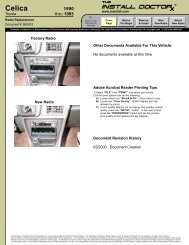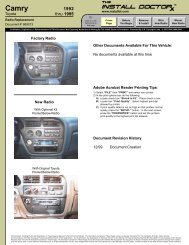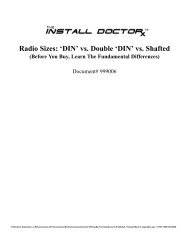999801 - AM-FM Reception Problems - The Install Doctor
999801 - AM-FM Reception Problems - The Install Doctor
999801 - AM-FM Reception Problems - The Install Doctor
Create successful ePaper yourself
Turn your PDF publications into a flip-book with our unique Google optimized e-Paper software.
<strong>AM</strong>/<strong>FM</strong> <strong>Reception</strong> <strong>Problems</strong><br />
(Simple Checks To See What Is Causing Bad <strong>Reception</strong>)<br />
Document# <strong>999801</strong><br />
Publication, Duplication, or Retransmission Of This Document Not Expressly Authorized In Writing By <strong>The</strong> <strong>Install</strong> <strong>Doctor</strong> Is Prohibited. Protected By U.S. Copyright Laws. © 1997,1998,1999,2000.
99% Percent Of <strong>Reception</strong> <strong>Problems</strong><br />
Almost every reception problem is caused by one of two things: a bad ground on the antenna, or a bad antenna cable running from the<br />
antenna to the radio.<br />
<strong>The</strong>re are (2) parts to an antenna and you have to understand the antenna cable itself. Antenna cables are coaxial style cables. Coax<br />
cables have a thin center conductor wire at the center of the cable and an outer metal braid just under the plastic jacket of the cable.<br />
<strong>The</strong> center conductor carries the signal and the outer shield serves two purposes, it shields the inner conductor from radiated noises<br />
and acts as the negative voltage path. 99% of antenna reception problems can be traced to either one of these two parts of the antenna<br />
cable.<br />
Bad Grounds At <strong>The</strong> Antenna<br />
Bad grounds are synonymous with static on the <strong>AM</strong>/<strong>FM</strong> reception. Bad grounds are caused by a couple of things: the base of the<br />
antenna is loose, or there is corrosion on the antenna connector plugged into the radio.<br />
<strong>The</strong> base of the antenna is loose: most antennas a secured to the frame of the vehicle by clamping or “sandwiching” the base<br />
of the antenna to the metal frame of the vehicle. This effectively grounds the antenna to the frame of the vehicle. When the<br />
base of the antenna loosens from vibration, the ground path between the frame of the vehicle and the antenna input of the<br />
radio tends to gain electrical resistance. This added electrical resistance is carried through the metal braided shield inside the<br />
antenna cable and is picked up by the tuner inside the radio. This resistance can cause static on the <strong>AM</strong>/<strong>FM</strong> reception.<br />
Corrosion on the antenna cable connector plugged into the radio: the concept is the same, corrosion causes an increase in<br />
resistance between the metal braided shield inside the antenna cable and the ground of the antenna input of the radio. This<br />
increase in resistance caused by corrosion is also picked up by the tuner inside the radio and can cause static on the <strong>AM</strong>/<br />
<strong>FM</strong> reception.<br />
A Bad Antenna Cable - Or A ‘Broken’ Center Conductor Wire Inside <strong>The</strong> Cable<br />
Here is a common complaint: “I get good <strong>FM</strong> reception, but I get lousy <strong>AM</strong> reception”. This may sound familiar to you???<br />
A radio can get <strong>FM</strong> reception just by having large objects near the radio. But, <strong>AM</strong> reception is very dependent upon the mast of the<br />
antenna outside of the vehicle. This mast is nothing more than an extension of the center conductor inside the antenna cable. It is<br />
common for the thin, hairlike center conductor inside the antenna cable to break. When this happens, the antenna mast outside of the<br />
vehicle is NOT connected to the radio anymore. As a result, <strong>AM</strong> reception is usually lost or at least very bad.
Simple Tests To Check For Antenna <strong>Problems</strong><br />
How to check the center conductor of the vehicles antenna cable<br />
Digital Multimeter<br />
(set to read resistance)<br />
How To Set Up <strong>The</strong> Multimeter:<br />
1) Set the multimeter to read resistance or ohms<br />
2) Connect one lead to the antenna mast<br />
3) Connect the other lead to the center pin<br />
on the antenna cables connector at the radio<br />
What To Look For:<br />
Resistance<br />
Ω (Ohms)<br />
Antenna Mast<br />
On Vehicle<br />
If both leads are connected together, the multimeter<br />
would read “0.0” ohms. Since the antenna mast is<br />
connected to the center pin of the antenna cable<br />
connector by the thin inner conductor inside the<br />
cable, connecting the leads to each will be the same<br />
as connecting the leads together. Doing this will<br />
test the center conductor inside the cable.<br />
<strong>The</strong> multimeter should read between 0 to 2 ohms.<br />
Center Pin Of <strong>The</strong> Antenna Cable Connector<br />
Plugged Into <strong>The</strong> Rear Of <strong>The</strong> Radio<br />
How to check the antenna cable to see if it has a solid electrical ground<br />
How To Set Up <strong>The</strong> Multimeter:<br />
1) Set the multimeter to read resistance or ohms<br />
2) Connect one lead to shiny metal inside the dash<br />
3) Connect the other lead to the outer metal sleeve<br />
on the antenna cables connector at the radio<br />
What To Look For:<br />
Resistance<br />
Ω (Ohms)<br />
Touch To Shiny Metal<br />
Inside <strong>The</strong> Vehicles Dash<br />
If both leads are connected together, the multimeter<br />
would read “0.0” ohms. <strong>The</strong> outer metal sleeve on<br />
the antenna cable connector is actually grounded<br />
to the vehicle at the antenna itself. Thus, the outer<br />
metal sleeve should be the same as any shiny metal<br />
surface in the vehicle and conduct through the<br />
multimeter when one probe touches metal and the<br />
other touches the metal sleeve on the connector.<br />
<strong>The</strong> multimeter should read between 0 to 2 ohms.












